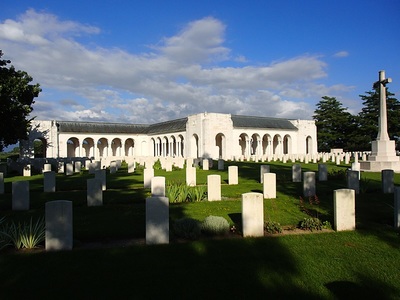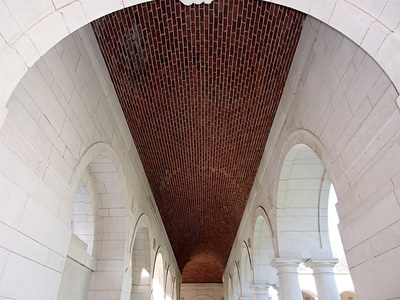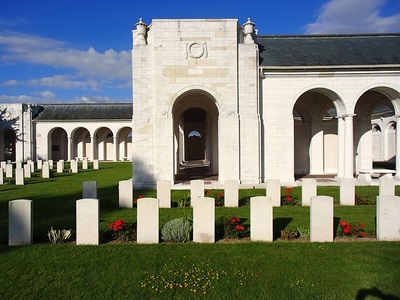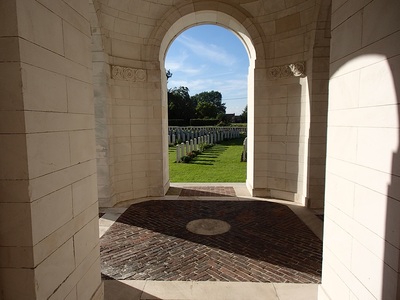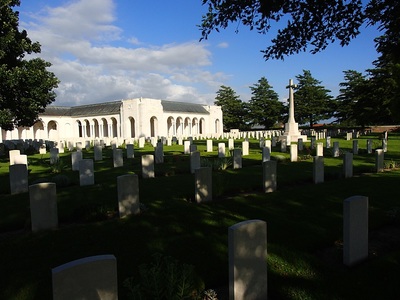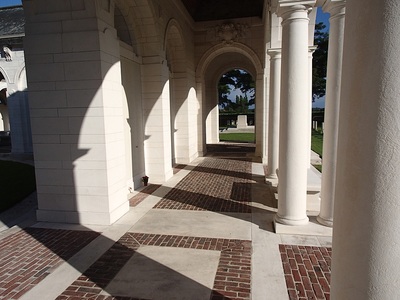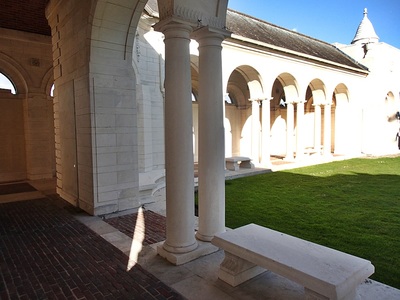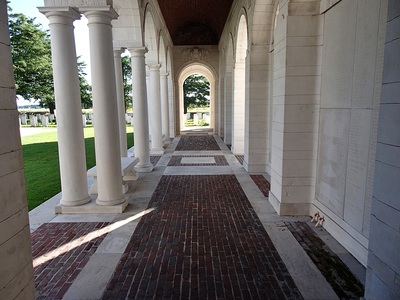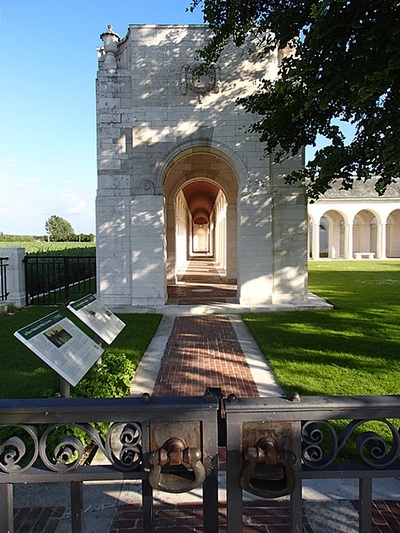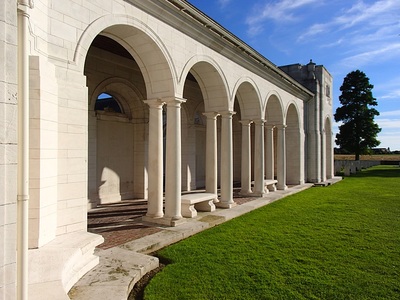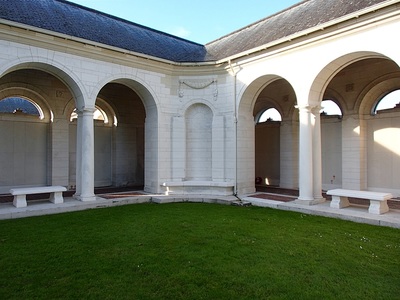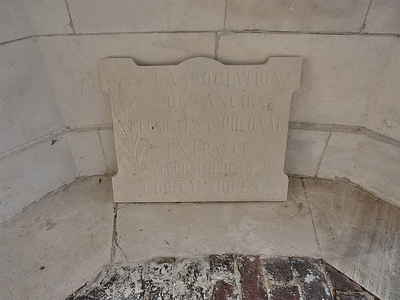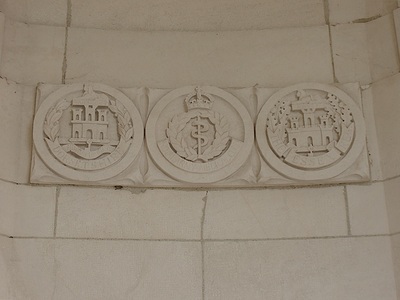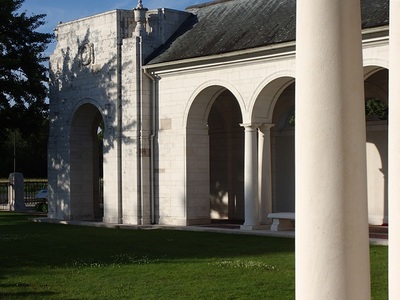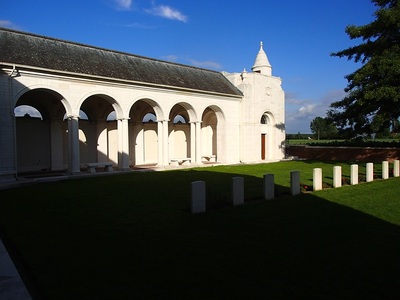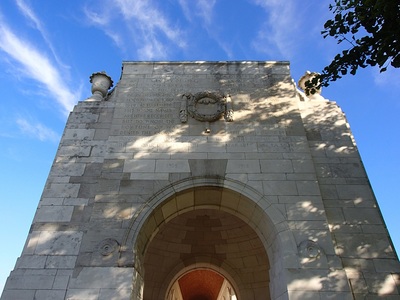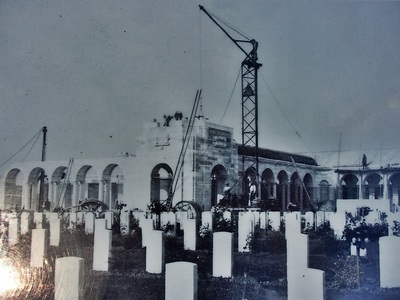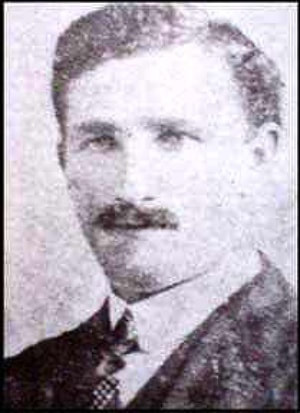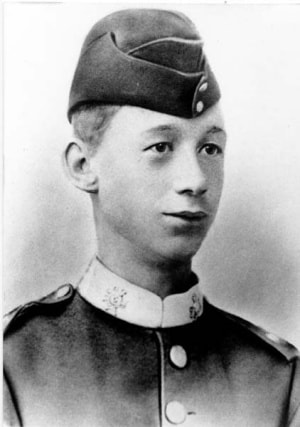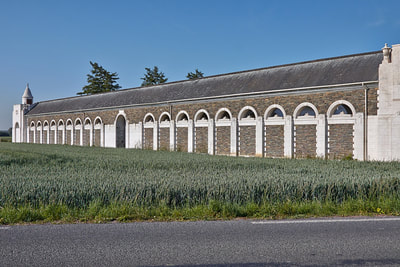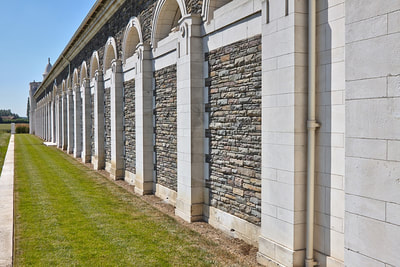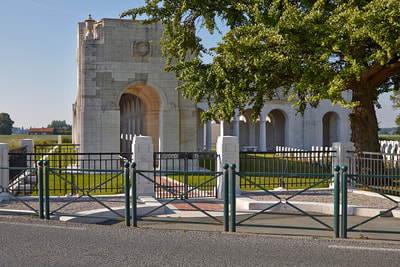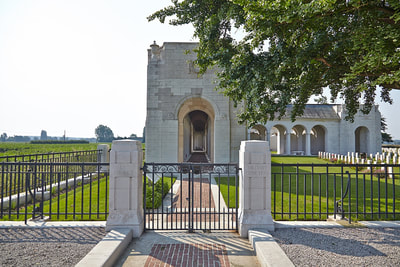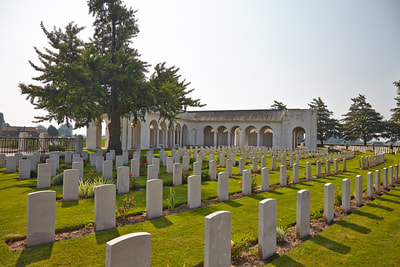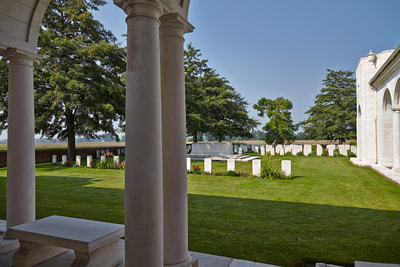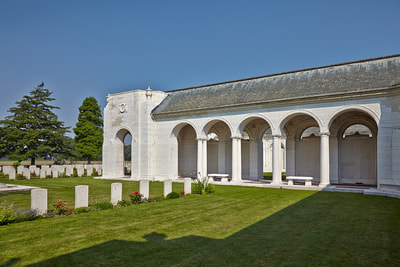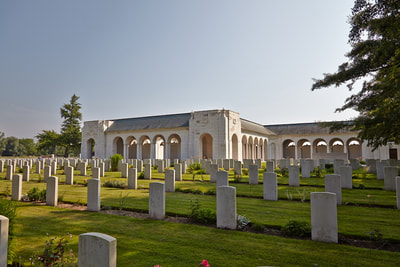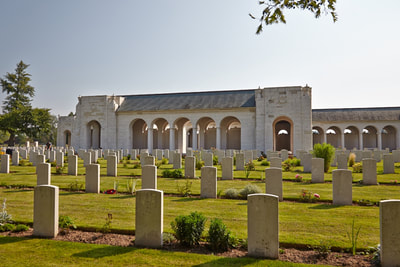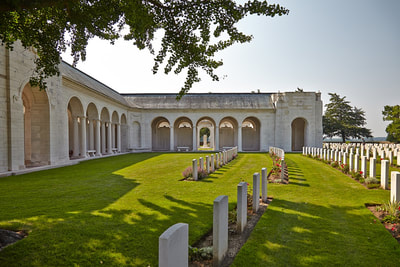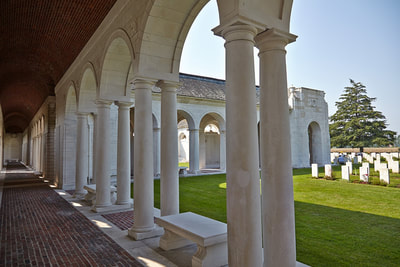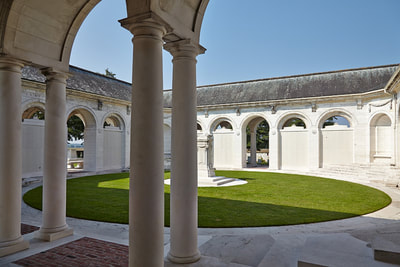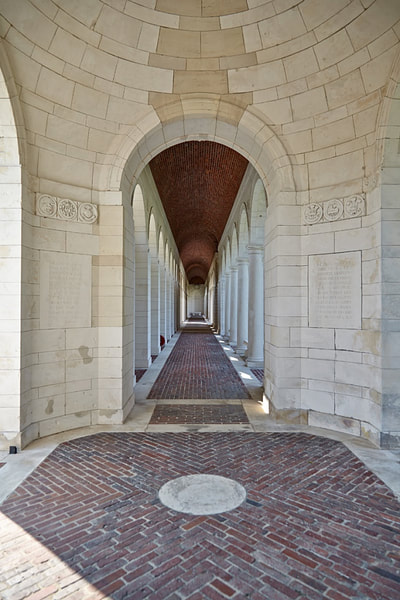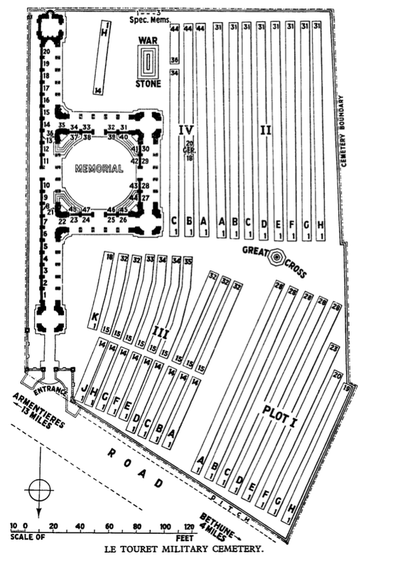LE TOURET MEMORIAL
Pas De Calais
France
Roll of Honour
Listed by Surname
Location Information
Le Touret Memorial is located at the east end of Le Touret Military Cemetery, on the south side of the Bethune-Armentieres main road.
From Bethune follow the signs for Armentieres until you are on the D171. Continue on this road through Essars and Le Touret village. Approximately 1 kilometre after Le Touret village and about 5 kilometres before you reach the intersection with the D947, Estaires to La Bassee road, the Cemetery lies on the right hand side of the road.
The Memorial takes the form of a loggia surrounding an open rectangular court. The court is enclosed by three solid walls and on the eastern side by a colonnade. East of the colonnade is a wall and the colonnade and wall are prolonged northwards (to the road) and southwards, forming a long gallery. Small pavilions mark the ends of the gallery and the western corners of the court.
Visiting Information
The Panel Numbers quoted at the end of each entry relate to the panels dedicated to the Regiment served with. In some instances where a casualty is recorded as attached to another Regiment, his name may alternatively appear within their Regimental Panels. Please refer to the on-site Memorial Register Introduction to determine the alternative panel numbers if you do not find the name within the quoted Panels.
Historical Information
The Le Touret Memorial
The Le Touret Memorial commemorates 13,479 British soldiers who were killed in this sector of the Western Front from the beginning of October 1914 to the eve of the Battle of Loos in late September 1915 and who have no known grave. The Memorial takes the form of a loggia surrounding an open rectangular court. The names of those commemorated are listed on panels set into the walls of the court and the gallery, arranged by regiment, rank and alphabetically by surname within the rank. The memorial was designed by John Reginald Truelove, who had served as an officer with the London Regiment during the war, and unveiled by the British ambassador to France, Lord Tyrrell, on 22 March 1930.
Almost all of the men commemorated on the Memorial served with regular or territorial regiments from across the United Kingdom and were killed in actions that took place along a section of the front line that stretched from Estaires in the north to Grenay in the south. This part of the Western Front was the scene of some of the heaviest fighting of the first year of the war, including the battles of La Bassée (10 October – 2 November 1914), Neuve Chapelle (10 – 12 March 1915), Aubers Ridge (9 – 10 May 1915), and Festubert (15 – 25 May 1915). Soldiers serving with Indian and Canadian units who were killed in this sector in 1914 and ’15 whose remains were never identified are commemorated on the Neuve Chapelle and Vimy memorials, while those who fell during the northern pincer attack at the Battle of Aubers Ridge are commemorated on the Ploegsteert Memorial.
The British Expeditionary Force in French Flanders, 1914 - 1915
In October 1914, II Corps of the British Expeditionary Force moved north from Picardy and took up positions in French Flanders where they were immediately engaged in the series of attacks and counter attacks that would become known as the ‘race to the sea’. Over the course of the next year most of the British activity in this sector focused on attempting to dislodge the German forces from their advantageous position on the Aubers Ridge and capture the city of Lille, a major industrial and transport centre which the Germans had occupied early in the war. The ridge is a slight incline in an otherwise extremely flat landscape from which the Germans were able to observe and bombard the British lines. Following the British capture of the village of Neuve Chapelle in March 1915, the Germans greatly strengthened their defences along the ridge, reinforcing their positions with thick barbed wire entanglements, concrete blockhouses and machine gun emplacements. These extra defences frustrated British attempts to break through enemy lines and led to very heavy casualties at the battles of Aubers Ridge and Festubert in May 1915.
Commemorated on Memorial: United Kingdom 13,478, India 1. Total 13,479.
Le Touret Military Cemetery
The men of the Indian Corps began burying their fallen comrades at this site in November 1914 and the cemetery was used continually by field ambulances and fighting units until the German spring offensive began in March 1918. Richebourg L’Avoue was overrun by the German forces in April 1918, but the cemetery was used again in September and October after this territory was recaptured by the Allies. Today 915 Commonwealth servicemen who were killed during the First World War are buried here.
Identified Casualties: United Kingdom 889, Canada 11, India 9, Germany 4. Total 913.
10694 Private Abraham Acton V. C.
|
8191 Corporal William Anderson V. C.
|
15518 Private Edward Barber, V. C.
|
6016 Private Jacob Rivers, V. C.
|
Cemetery pictures below © Geerhard Joos
Shot at Dawn
14232 Private Joseph Ball, 4th Coy. 2nd Bn. Middlesex Regiment, executed for desertion 12th January 1915 aged 20. Panel 31 and 32. Son of Thomas and Emily Ball, of 112, Lancefield St., Queen's Park, London.
14164 Private F. Sheffield, 2nd Bn. Middlesex Regiment, executed for desertion 12th January 1915, aged 26. Panels 31 and 32. Brother of James Sheffield, of 42, Franklin St., South Tottenham, London.
Both regular soldiers, Private Ball and Private Sheffield deserted together after only 6 weeks’ active service, as their battalion moved up for an attack on Neuve Chapelle;& were discovered hiding under straw in a barn, claiming to be French civilians. (Putkowski,p,29)
70304 Driver John Bell, 57th Bty, Royal Field Artillery, executed for desertion 25th April 1915. Panel 1. Son of John Bell, of Finglas, Co. Dublin.
5231 Private James Briggs, 2nd Bn. Border Regiment, executed for desertion 6th March 1915. Panel 19 and 20.
A re-enlisted special reservist, he joined his battalion on 10 Jan 1915. On 20 Jan, Briggs was missing from the morning roll-call at Sailly; & in the evening of Jan 22 was found at Le Havre hiding, along with a Pte Gardner, in the hold of the Southampton mail-boat. He pretended that he had been sent to a hospital ship, but being without a movement order or travel warrant, he was arrested & detained in a local guardroom — from which he escaped during the night of Dec 30, only to be found the next morning drunk in a bar in the town.
At trial, he put up no defence whatsoever. After verdict, 5 previous convictions for absence were revealed. When Briggs was invited to say something in mitigation, he merely stated that: ‘I was taken from my house when I was 15, & have never seen my parents since’. With such a record, & his desertion being considered ‘planned & deliberate’, sentence was readily confirmed. (It is not known how his companion on the ship was dealt with)
(Corns, pp 240-242)
2222 Private Thomas Cummings, 1st Bn. Irish Guards, executed for desertion 28th January 1915. Panel 4. Son of William Cummings, of Tully Muckamore, Belfast.
3379 Private Albert Smythe, 1st Bn. Irish Guards, executed for desertion 28th January 1915. Panel 4.
Private Cummings and Private Smythe had served for several years before the war. Their battalion, which had been in action continually since Mons, was fighting in the Ypres Salient when in November 1914, the 2 men deserted. A French woman harboured them until they were found during a raid by the Royal Military Police on a farm. At trial, the battalion commander stated Cummings to be an excellent soldier, but that Smythe’s reputation was disappointing.
(Putkowski,pp 30-31)
6584 Private Alexander Sinclair (Served as John Duncan), 1st Bn. Cameron Highlanders, executed for desertion 7th March 1915. Panel 41 and 42. Son of William Cummings, of Tully Muckamore, Belfast.
He deserted after only a week in action. After execution, his name appeared in the official casualty records as having died of wounds. (Putkowski,p 37)
5919 Private Edward Tanner, 1st Bn. Wiltshire Regiment, executed for desertion 27th October 1914, aged 33. Panel 33 and 34.
He was a Regular, who had served at Mons, Le Cateau, on the Marne & on the Aisne, before he was transferred to Flanders.
On 18 Oct 1914, he was in a party of men which stopped at a village on their line of march, & at 2030, Tanner was found to be missing. On the morning of 19 Oct, he was seen in plain clothes by an officer from another regiment in a nearby village, & arrested. On the way back to his battalion, Tanner pointed out the house where he had hidden his rifle & equipment.
At trial — unrepresented, & not contesting the evidence — Tanner explained that he had lost his party on the night, sought but failed to find his own regiment, & spent the night in the village. He had been ‘terribly overcome by nervousness from the heavy firing’, & did not know what he was doing, adding that his nerves had been shattered by the Battle of the Aisne.
After conviction, no character evidence was given, nor any as to his previous service. No medical examination seems to have taken place before confirmation. (Corns, pp. 313-314)
14232 Private Joseph Ball, 4th Coy. 2nd Bn. Middlesex Regiment, executed for desertion 12th January 1915 aged 20. Panel 31 and 32. Son of Thomas and Emily Ball, of 112, Lancefield St., Queen's Park, London.
14164 Private F. Sheffield, 2nd Bn. Middlesex Regiment, executed for desertion 12th January 1915, aged 26. Panels 31 and 32. Brother of James Sheffield, of 42, Franklin St., South Tottenham, London.
Both regular soldiers, Private Ball and Private Sheffield deserted together after only 6 weeks’ active service, as their battalion moved up for an attack on Neuve Chapelle;& were discovered hiding under straw in a barn, claiming to be French civilians. (Putkowski,p,29)
70304 Driver John Bell, 57th Bty, Royal Field Artillery, executed for desertion 25th April 1915. Panel 1. Son of John Bell, of Finglas, Co. Dublin.
5231 Private James Briggs, 2nd Bn. Border Regiment, executed for desertion 6th March 1915. Panel 19 and 20.
A re-enlisted special reservist, he joined his battalion on 10 Jan 1915. On 20 Jan, Briggs was missing from the morning roll-call at Sailly; & in the evening of Jan 22 was found at Le Havre hiding, along with a Pte Gardner, in the hold of the Southampton mail-boat. He pretended that he had been sent to a hospital ship, but being without a movement order or travel warrant, he was arrested & detained in a local guardroom — from which he escaped during the night of Dec 30, only to be found the next morning drunk in a bar in the town.
At trial, he put up no defence whatsoever. After verdict, 5 previous convictions for absence were revealed. When Briggs was invited to say something in mitigation, he merely stated that: ‘I was taken from my house when I was 15, & have never seen my parents since’. With such a record, & his desertion being considered ‘planned & deliberate’, sentence was readily confirmed. (It is not known how his companion on the ship was dealt with)
(Corns, pp 240-242)
2222 Private Thomas Cummings, 1st Bn. Irish Guards, executed for desertion 28th January 1915. Panel 4. Son of William Cummings, of Tully Muckamore, Belfast.
3379 Private Albert Smythe, 1st Bn. Irish Guards, executed for desertion 28th January 1915. Panel 4.
Private Cummings and Private Smythe had served for several years before the war. Their battalion, which had been in action continually since Mons, was fighting in the Ypres Salient when in November 1914, the 2 men deserted. A French woman harboured them until they were found during a raid by the Royal Military Police on a farm. At trial, the battalion commander stated Cummings to be an excellent soldier, but that Smythe’s reputation was disappointing.
(Putkowski,pp 30-31)
6584 Private Alexander Sinclair (Served as John Duncan), 1st Bn. Cameron Highlanders, executed for desertion 7th March 1915. Panel 41 and 42. Son of William Cummings, of Tully Muckamore, Belfast.
He deserted after only a week in action. After execution, his name appeared in the official casualty records as having died of wounds. (Putkowski,p 37)
5919 Private Edward Tanner, 1st Bn. Wiltshire Regiment, executed for desertion 27th October 1914, aged 33. Panel 33 and 34.
He was a Regular, who had served at Mons, Le Cateau, on the Marne & on the Aisne, before he was transferred to Flanders.
On 18 Oct 1914, he was in a party of men which stopped at a village on their line of march, & at 2030, Tanner was found to be missing. On the morning of 19 Oct, he was seen in plain clothes by an officer from another regiment in a nearby village, & arrested. On the way back to his battalion, Tanner pointed out the house where he had hidden his rifle & equipment.
At trial — unrepresented, & not contesting the evidence — Tanner explained that he had lost his party on the night, sought but failed to find his own regiment, & spent the night in the village. He had been ‘terribly overcome by nervousness from the heavy firing’, & did not know what he was doing, adding that his nerves had been shattered by the Battle of the Aisne.
After conviction, no character evidence was given, nor any as to his previous service. No medical examination seems to have taken place before confirmation. (Corns, pp. 313-314)

c.1930; The mother of Private William Purves points to his name on the Le Touret memorial. 4763 Private William Purves, 2nd Battalion Scots Guards, of Maffra, Victoria. Pte Purves was mobilised by the British Army on 14 August 1914 and embarked for France from Melbourne aboard HMAT Berrima on 22 December. He was killed in action on 18 May 1915 aged 31. Son of Jean Purves, of Musselburgh, Midlothian, and the late David Purves; husband of Maud Esther Purves, of Main St., Pakenham East, Victoria, Australia


